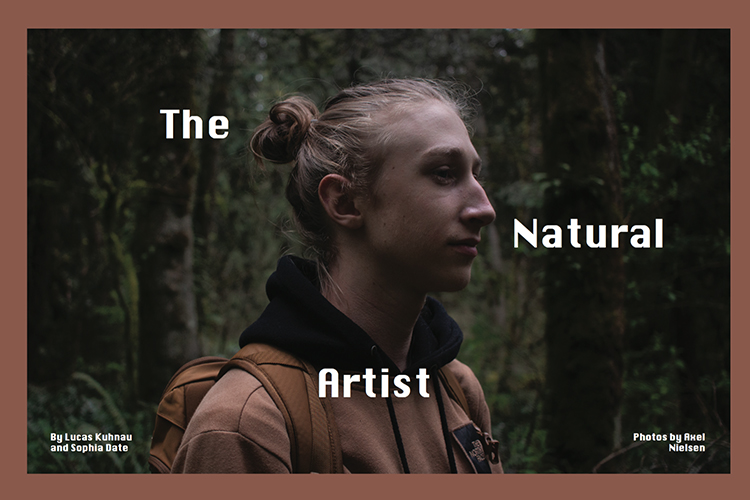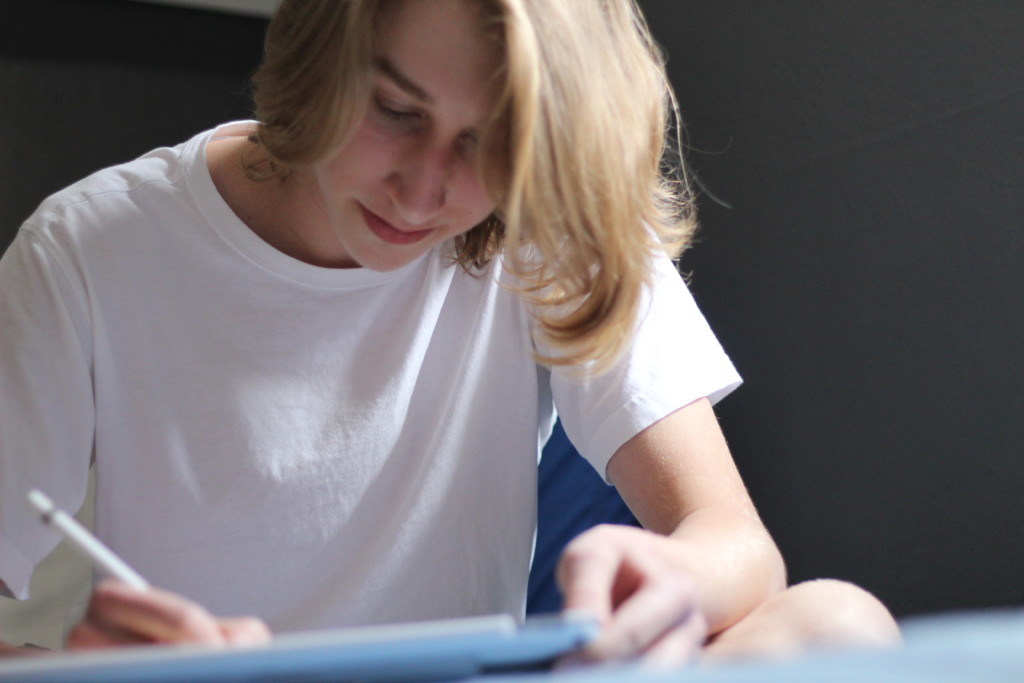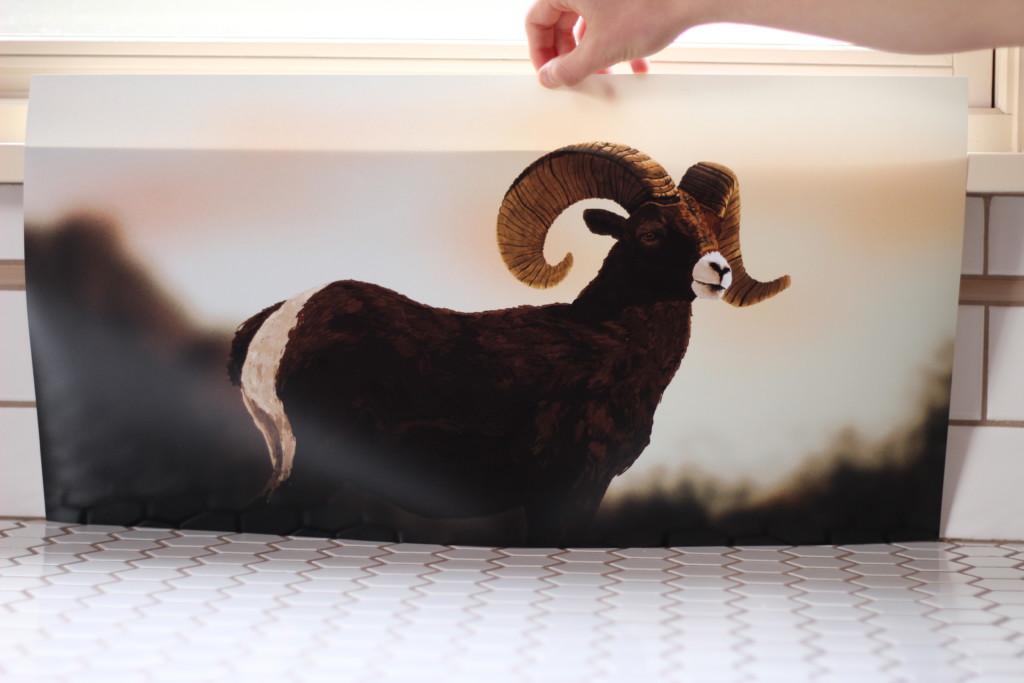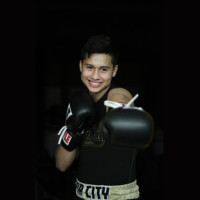
The ground is soft underfoot, and the cold air stings, but sophomore Nico Westarp appears unfazed as he hikes along a muddy path connected to the larger Forest Park area. Equipped with comfortable clothing, a backpack and a reusable water bottle, he is well-prepared to hike. He talks evenly as the path’s slope increases, continuing a steady stream of quips along the way.
When asked what kind of weather he would be, Westarp says, “Like a barometric pressure of 10. There’s a light wind blowing from the southeast. The cloud cover recently disappeared.” His words do not falter once, and he continues to answer without breaking character.
He is relaxed, talkative and content. Here, Westarp is unbothered by the things in his daily life. His attitude in the woods resembles the way he appears as he is drawing. With a stylus and iPad Pro in hand, he seems at home. His concentration while creating art is reminiscent of his time outside, quiet and steady, his focus absorbed by what is in front of him.
Westarp established his interest in art at an early age. Since he was young, Westarp has been developing his skills, drawing whatever comes to mind. He followed in his sister’s footsteps, developing his own style along the way.
“His older sister Josephine was always a prolific artist from the get-go, and I think he just saw her drawing all the time and he took it up too, and he created a comic strip, ‘Dumb Bunnies’, and then his work has really evolved from there,” says Lisa Westarp, his mother. This passion for drawing evolved into a means for relaxation, allowing him to be “in the moment.” For Nico Westarp, art is meditative.
Westarp finds time to create art every chance that he gets. Most days after school, he retreats to his room to work on a new piece for at least half an hour. On weekends, he can be found lying on his bed sketching for hours on end. As he works, the art flows from his hand onto the screen. He guesses that it took him about seven hours to complete a drawing of a hummingbird, each part of its tiny wings crafted in half-hour blocks of painstaking detail. The art that Westarp creates, while not a direct reflection of him, is drawn like an extension of him. “I don’t think that he thinks that putting himself into his art makes it more valuable,” says Westarp’s friend Olisa Ikejiani.

When Westarp is at work, he blocks out all distractions surrounding him. Furrowing his brow in concentration, he sketches an image of a bird with blue and yellow detailing, making it pop. The vivid colors flash across the screen, invigorating the piece with an energy only found in a drawing. Each line is drawn with a precision resembling a photograph.
Westarp’s art has become a point of identity for him. “I guess that’s kind of what people know me for. I guess my friends will show (my art) to people, and they’ll be like, ‘Oh, you’re the person who draws that,’” he says.
Westarp has stayed true to himself by continuing to pursue both his interest in nature and his interest in art.
He has been driven to create art since he was little. When he was young, he preferred only creating comics. His mother could buy his sketchbooks, onto which his drawings cascaded haphazardly. Eventually, his artwork manifested into “these really weird comic books.” He adds, “Basically, I just didn’t care about making it coherent or anything, it’s just like chaos, but I think they’re funny.”
Even then, his artistic ability was advanced. “It’s so expressive that with so few lines, he conveys so much emotion and energy,” says Lisa Westarp, discussing a comic he made when he was only 5.
As a child, Nico Westarp did not harbor the same fondness for nature that he did for art. “When I was a little kid, I actually hated that kind of thing, like, my family would try to take me on hikes, and I just wouldn’t go,” he says. “I guess because I was being made to go on hikes and it wasn’t my idea.”
Westarp’s view began to shift due to his visits to his grandparents’ ranch in West Texas. “We would go out there in the mountains … and we did a lot of hiking, and he did a nature camp at a nature preserve there. And those were some early experiences,” says Lisa Westarp, reminiscing on their time in West Texas.
“We’d go there every summer, and I remember one night, it was in winter, and there was no moon and a lot of stars, and I was outside, and I could hear the coyotes howling. It was really nice,” Nico Westarp says.
He began taking horseback riding lessons during his time in West Texas, learning alongside his mother, who had been riding for years. It was also the place he went on his first overnight camping trip, something that sparked his continual love for the outdoors.
Westarp also began to learn about nature through books. “I remember reading this book about birds, and I started kind of getting interested in that,” he says. “And then sixth grade, I read this book called ‘My Side of the Mountain.’ It’s about this kid who runs away and lives in the forest, and then that same year, I went to outdoor school. I guess that kind of made me appreciate it.”
From reading books, Westarp began to make them, adding to his comic strips so that they became full comic books. The 1960s Batman television series, with its flashy colors and cheesy caricatures, inspired some of his earliest work. “They had the sound effects on the screen, and I thought that was like really corny, so I made fun of it,” he says. “The first comic book I made was called ‘Super Pizza Guy,’ and it’s about this guy who has pizza superpowers, it’s really weird.”
Ikejiani says, “I think that it was something that he did, that he loved to do like it was just a tool to make things.” Ikejiani has known Westarp and followed his progression as an artist since the two were in seventh grade. To Westarp, his comic-making phase was just that: a phase. It was something he cared about at the time, but as he grew as a person, his art changed with him. Westarp says that his work has “matured and increased in quality.”

As he grew as an artist, his love for nature started to fit perfectly into his art. Constantly observing the world around him, Westarp began to transfer this knowledge onto paper, allowing the things that he saw while in nature to fuel his art.
Now, at the age of 16, he digitally sketches animals in their natural habitats: his two passions have interwoven themselves. He spends extended periods of time simply drawing, sketching ideas until he finds something he likes. Once he has settled upon an idea, usually an animal, he finds many pictures of that animal to use as a reference to create his sketches.
In April of this year, he worked as an Outdoor School student leader, where he supervised a group of middle schoolers and taught them lessons about the outdoors. Westarp reflects on the experience, saying, “I went to Camp Howard, which is somewhere in Oregon, and I was a student leader … So I had to lead sixth graders – help them learn about nature and the world that we live in.”
Each student leader was assigned one of four topics to teach the students about: soil, animals, water or plants. By pure luck, Westarp was assigned animals, allowing him to teach something he was especially passionate about. “In the morning, we’d have different stations set up, like pellets and stuff, and we teach them about animal adaptation. There’s a certain thing in each station, like there was one with skulls, another with beavers, another with birds, another with pellets,” says Westarp. “And the goal was to just teach them about animal adaptations and how they fit into the ecosystem. And that’s what we did in the mornings, and then in the afternoons we’d take them on a hike where we’d have to teach them to look for signs of animals in the forest.”
After returning from his week at Camp Howard, he expressed his appreciation and his hope to return next year. He particularly enjoyed connecting with the students, adding that one of them even said that he wanted to name his son after Westarp.
His ability to relate to the middle schoolers is a result of his relaxed personality. As he says, “My friends say I’m chill. I guess I’m not like loud or crazy, not like introverted, but I think I’m quiet. I like other people. I’m just not a super talkative person.”
Lisa Westarp would add “motivated” to that description of Nico Westarp. In most areas of his life, specifically his hobbies, Westarp has pursued things purely on his motivation. “He has developed his own sense of integrity. I never really set any rules or expectations, but he has high expectations for himself,” says Lisa Westarp. “He’s showed me what he’s going to have in the trade show and I was just blown away.”
That motivation led Westarp to use his time at Camp Howard as the inspiration for one of his new art pieces. “It was raining the whole time I was there, and it was a vibe, so the one I’m working on now is kind of dark and moody,” Westarp says.
Westarp has begun to share his art with others through his Instagram account and says he has received positive feedback. He adds that it “makes him feel good about his art.” One of his friends, sophomore Tucky Helm says, “Nico’s art is very cool. When I first followed him on Instagram and saw all his art posts, I thought that they were photos. When I looked closer and saw that he made all of them, I couldn’t believe it. All of his art is super realistic, even when you zoom in. I’m especially impressed because he doesn’t trace a photo; the scene in all of his pieces is completely from his imagination.”
Westarp’s interest in nature, in contrast, is not as widely known to his peers. Ikejiani says that Westarp rarely shares anything regarding nature unless it is in the form of his art. “I know that, from what I can see in his art … it isn’t overly stylized, I’ll say. Everything is pretty anatomically accurate, things make physical sense,” he says. “I think you can see that he really cares about the nature and the correctness of his work.”
Westarp’s infatuation with the natural world goes beyond artistry, as he plans to pursue a career outdoors. “I still enjoy art, but having a career in art, I don’t think I’d enjoy that. It would take my enjoyment out of it because it’s just deadlines, and you don’t get to make what you want to make. Because, it’s kind of different. With art you’re making something; with nature I guess you kind of just go out and experience it,” he says.
However, even though he does not appear to be on the career track toward art, that does not mean that he will stop making art entirely. He says that he would still like to continue doing art when he is older, but as more of a hobby.
His mother possesses the same beliefs for Westarp’s future. “I think he will pursue something in environmentalism and I think he’ll continue his art too. And I’m really happy to see how the two are merging now when he showed me the nature art he’s made for the trade show.”
Westarp has created a space for himself in the world. From his keen eye for color and his vast appreciation of the outdoors, he has come into the person he is almost entirely on his own.
Whether he is outside, taking in the details of the trail ahead of him or simply sitting at home, studying a collection of carefully chosen images to inspire his next work, Westarp has let the things he truly cares about shape his life.
As he sits contemplatively at his desk, stylus in his hand, he makes small marks that alone seem like nothing, but together make a picture-perfect image. He has brought this same sense of balance into his everyday life. At only 16 years old, he is notably self-motivated and prepared for his future. While that future is not yet clear, there is no doubt that his path to get there will be as unique as he is.




